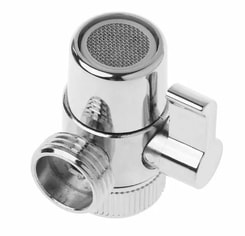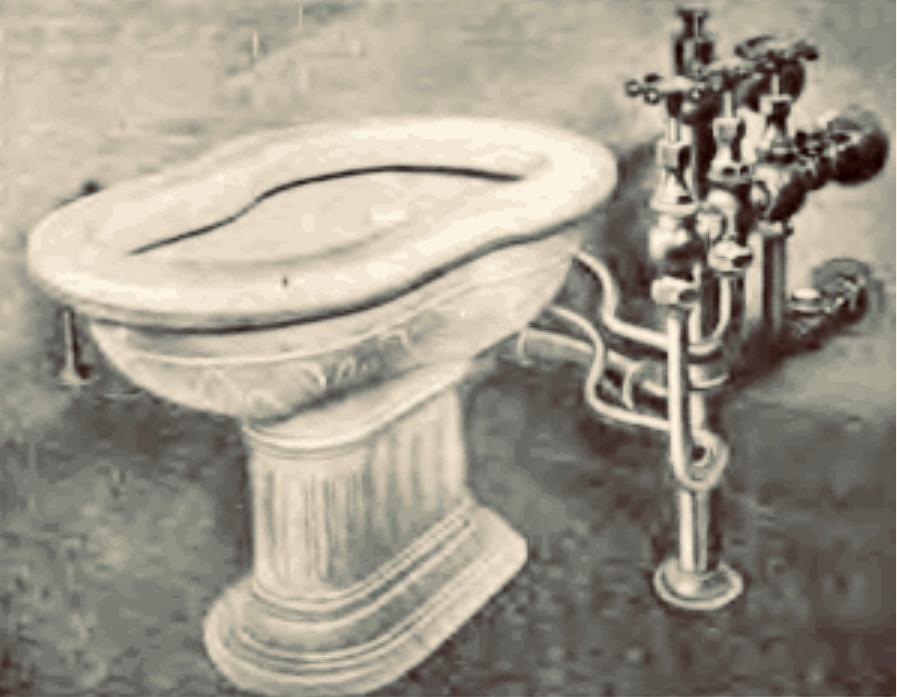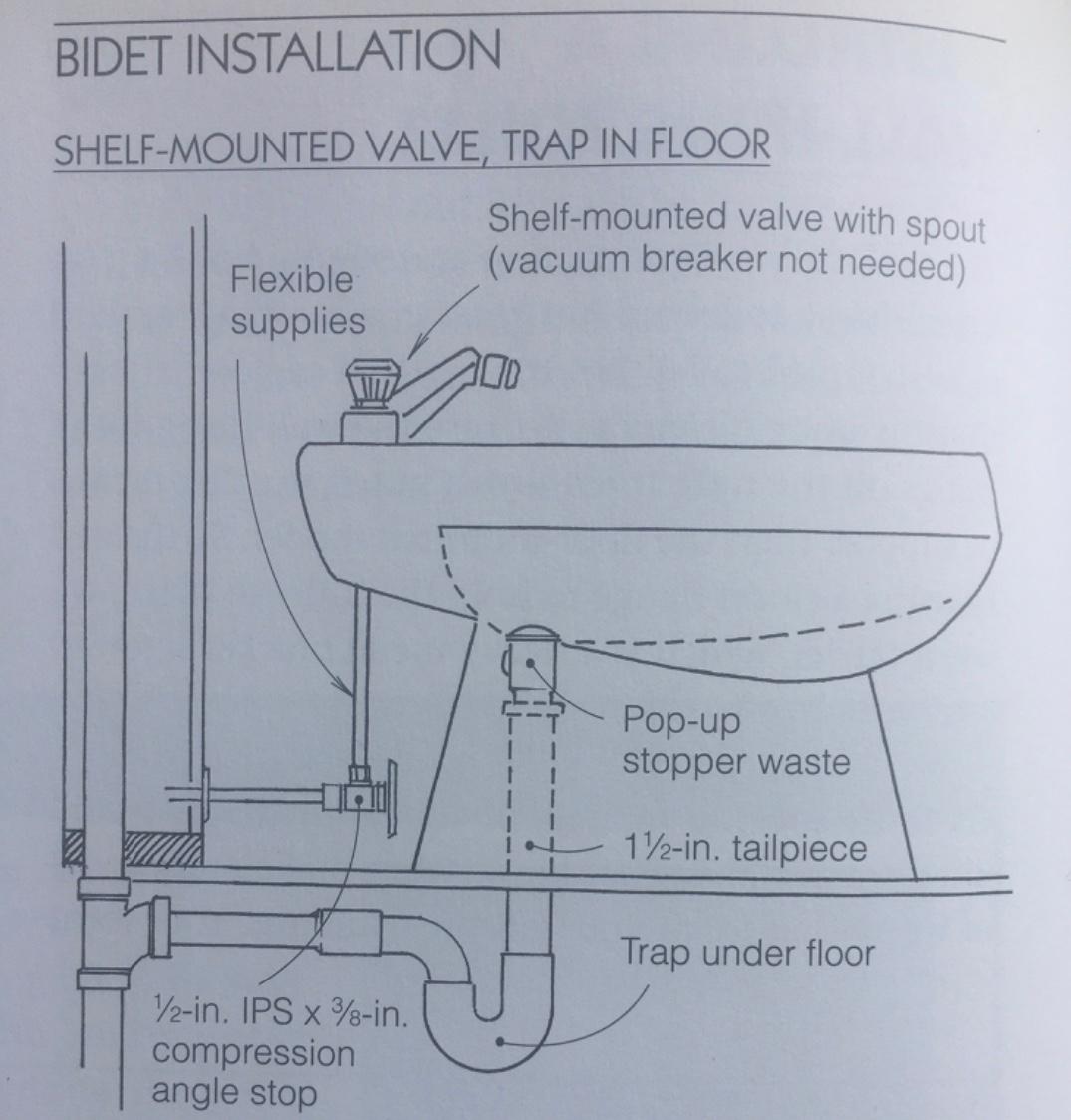|
Greetings To One And All Crazy Times Between hurricanes, a recession, and a pandemic, how are you managing? PtP has been hunkered down and keeping busy with hobbies which explains his of late word scarcity. He though, has noticed an uptick in book sales and readers’ questions. He figured this might be due to a financial squeeze on the planned, previously-to-be, contracted projects of his reader? The possibility of losing audience to Covid occurred to him too. (How many might now be m.i.a.?) Yours truly is of an August age which has been recently more than well informed on healthy pandemic habits. So methought this post would be the perfect ‘couch-time’ activity to keep old Pete inside and ‘distancing.’ Now, due to WAY too much shelter in place electronic device time, the author has noticed a flood of advertisements pertaining to an aspect of my last post: toilet paper and personal hygiene. These online adverts are urging the public to adopt a different method of personal hygiene, and be ‘done with’ toilet paper by using pressured hydro to wash your bum clean, instead of wiping post poop. The author’s concern with this new on-the-scene toilet bidet involves a physics issue, and by illuminating the functioning of traditional bidets he hopes to assure your possible adoption of a toilet bidet be a safe practice. This is underwritten by the addition of a little known, important plumbing device NOT necessarily included in the inexpensive, foreign designed and manufactured toilet bidet now appearing in so many on-line adverts. This little gem of a plumbing part is discussed and illustrated in The Lone Ranger To The Rescue, near the end of the article. As for toilet bidets, while cruising the NET in search thereof, the reader will see hundreds of ads for the same means (and mostly the same product). It’s a hand held bidet ‘handset’. It consists of a nozzle/handle; a flexible metal hose; and a diverter valve. The diverter valve allows the existing cold water supply for the toilet to be the source for the handset also. This particular design of bidet is marketed for cleaning human ‘bottoms’ following a poop, without the need for toilet paper (or much of). PtP is all for this new campaign, but as he mentioned above he wants to raise a red flag (and offer a few complementary suggestions). Before we slide into this technical ‘head’s-up’ topic, the author first wants to air some historical perspectives of the long in use bidet, as we’ve known it. Little Horse Water, and especially moving water, from time immemorial has been utilized for dispensing with human waste. The Minoans, Etruscans and Romans were especially adept at it. Where the author would like to launch this post is when we begin to see objectively depicted (posh) ladies astride a bidet. (Photo 1): Men, no snickering. With your adoption, you would find your appreciation thereof increasing as you aged, in dealings with overly saturated methane, for one. OK. Now. Why is a bidet called a bidet? Well, if you haven’t already guessed, bidet is old French slang. It referred to a ‘little horse.’ When one (I) look at renderings of ‘bidets’ of early eras (Photo 2) the saddle shape of the fixture and the fact that the person, when using, sat astride only supports the slang story that stuck: little horse. These artfully rendered female members of the upper crust (most) were not using the bidet as a chamber pot but rather attending to their lady parts with (at the time) a quite convenient pool of mostly (for the times) clean, and most probably warmed water. Then, the fixture was portable. It was a vessel one squatted on and with the use of finger/s and more, cleansed themselves. Many who trusted the use of as birth control had big surprises. It wasn’t until we see stationary, piped bidets first appearing in American upper class housing during the early 1900’s (Photo 3) and becoming more common in 1940’s following World War 2, that directed flow and temperature of moving water became fashionable in this exercise. The author will have more to say about this further downstream. In the early 1960’s, apprentice Pete was becoming familiarized with the installation and workings of the two basic designs of supply and drainage plumbed, free-standing bidets, those accepted by municipalities’ and States’ building and safety codes. The ‘new ones’ he worked with then still utilized a p-trap in the floor. His at the time employer (Me and Angie) served a world-traveled clientele. Pete right away appreciated the complexity of fittings incorporated (and required by codes) for modern bidets. One of the two basic designs has fewer parts than the other. The fewer parts version is cheaper to manufacture and cheaper to rough plumb. But both designs though have to wrestle with physics to be accepted by codes. Both types of free standing (modern) plumbed (supply and drainage) bidet designs have a pop-up stopper (like bathroom sinks) to form (when desired) a pool in the bowl, (Photo 4). And, both designs employ ‘sprinkles-to-blasts’ of your choice-of-temperature water, in their functions. (That temperature selection aspect is a big deal and we’ll get into that shortly.) Because plumbers are known as protectors of the nation’s health (Photo 5) yours truly wanted to raise an issue concerning the recent effort by some to ‘dump’ toilet paper in favor of a hand held toilet bidet, for this purpose. This new interest blossomed alongside a Covid-19 related consumer supply problem: TP availability. However, the aspects of both temperature and directed water for said purpose, the author wishes to raise. PtP will begin with water temperature before water flow choices are discussed. Ice Cube The author admits (confesses) that the ‘morning after’ an over-indulgent (rack it up to youth) consumption of abalone stuffed Mexican hot chili peppers (in Mexicali), he discovered the most important use there is of an ice cube. But since these occasions (thankfully) were far and few, additional desire to have coldness ‘down there’ was not extended. If you are someone who, in spite of being limited to only cold water, would be interested in living with one of these remarkably low-priced off-shore sourced hand held toilet bidets now being advertised, PtP congratulates you. (Anyone who can make the adjustment to using only cold water this way: all the more to you!) With traditional, permanently installed bidet fixtures, to have them accepted by states and communities everywhere, they have to have met some important safety/sanitary codes, one of which keeps ‘everything’ directed in the safe direction: downstream. This is where the physics issue aforementioned comes into play. Back Siphonage In the plumbing code of jurisdiction for the author (Uniform Plumbing Code), a condition defined as a Cross Connection is the plumber’s greatest worry/concern. A mixture of waste water into a source of drinking water has long been known as an accomplice to death and ailment. It is an action that plumbers just cannot allow to happen. Today’s manufacturers of sanitary fixtures have to provide for a function that does not let waste water (water used) have any possible way to mix with fresh water supply. With plumbing fittings and materials, what the non-plumber effects in his/her bathing routine (by their own actions) must not constitute a Cross Connection. Below is the actual wordage of the code. “A connection or arrangement, physical and otherwise, between a potable water supply system and a plumbing fixture or a tank, receptor, equipment, or device, through which it may be possible for nonpotable, used, unclean, polluted, and contaminated water, or other substances to enter into a part of such potable water system under any condition.” (Spoken with beautiful legalese.) An accidental back siphonage of waste water from a bidet would constitute a cross connection. In the case of the permanently installed bidet fixture, one method to accomplish this safety/sanitation level is with the addition of an anti-siphon valve (Photo 6) on the water supply portion. (This valve and piping illustrated was common on earlier models which left the pipe and fittings exposed behind or on the back shelf of the fixture. To appear modern (at the time) the manufacturers decoratively electro plated the parts in chrome and more expensive finishes then in vogue.) A later style of free standing bidet popular to present, illustrated in Photo 7, the shelf mount, that maintains its favor with authorities (illustrated in: Installing And Repairing Plumbing Fixtures) employs an air gap (gap of free air). This design of bidet directs water flow to the bather’s anatomy from above, versus below the flood level rim of the fixture, as in a ‘rose-sprinkler’ design (Photo 8). The gap of air between the water issuing the shelf mounted valve spout illustrated in Photo 7 and the lower altitude of a bather’s exposed flesh, establishes a “safety distance” against any possible back siphonage and resulting cross connection should water supply be interrupted. Yours truly will have more to say about this choice, downstream. All quality plumbing manufacturers like to put their name or mark on their products, often with an additional mark of a regulatory agency for extra effect. For about a third of the lower 48 United States, reputable sanitary fixture/valve/equipment manufacturers mark their products with: UPC, sometimes within a shield facsimile. UPC are the initials of the Uniform Plumbing Code. Fixtures and valves that can exhibit that mark guarantee (with proper installation) that no back-siphonage occurs with their product, among other imperatives. To earn this sign of safety, manufacturers incur considerable design and manufacturing expense. Does the hand held toilet bidet product being sold online and even in some brick and mortar outlets exhibit the mark of the Uniform Plumbing Code? Or others? If it has passed UPC requirements by spending the bucks doing so, it would only make sense to advertise that fact with a UPC or other nationally recognized code symbol, prominently, somewhere on the item of manufacture, no? This brings us to the second point of interest in my argument: direction of flow for both waste and supply. Check Valve The average person in the US uses 9 squares of toilet paper per poop. Do the extrapolation and the possible environmental rewards of using less are plainly seen. (According to the Natural Resources Defense Council, toilet paper accounts for 15 percent of deforestation.) However, this switch of hygiene habits should be done safely, without the possibility of ‘cross connection’ through back siphonage. Does/did any possible hand held bidet product you purchase/d or are evaluating, have such a mark of approval like a UPC mark? If it doesn’t, does it mean one should not purchase it? Though PtP is rooting for toilet bidets, he does not want this to become a public health trade-off due to laypersons’ lack of code knowledge. If it’s going to happen, yours truly would like to see it safely handled. He proposes the addition of a consumer supplied, very reasonably priced check valve, readily available by a respected US manufacturer for just this purpose. (I’ll tell you more about this product downstream.) More on Anti-Siphon From a ‘rose-in-bowl’ plumber’s installation schematic (Photo 9), we are looking at a cross section of a rose/sprinkler anti-siphon and diverter valve, in one! This specially designed valve serves both a function change (directed spray or rinse-down-and-fill bowl), and at the same time provides the service of an anti-siphon valve. This valve prevents spent water collected in the bidets bowl from back siphoning up into the fresh water supply system through the ‘rose’/sprinkler. (The same precaution is taken for landscape sprinkling and watering.) The lower supply valve shown on the right would be the cold water supply. The hot water supply valve would be replicated on left side of this symmetrical fixture. This design of traditional bidet where the supply valves are under-hung (with trim above), on the back ledge/shelf of the vitreous fixture, and which through tubing connections, water is routed to the traditional rose (sprinkler head) in the bottom of the bowl, has long been the standard bearer of ‘top drawer.’ (And before it, the ‘in-the-wall’ valve and supply with sprinkler.) Back Shelf/Ledge The newer, second major free standing bidet fixture (Photo 10), (the design mentioned prior and illustrated in Photo 7) referred to as a “back shelf” design, again, escapes the requirement of the anti-siphon valve by the means of its natural (physics) air-gap. The bowl shape and ‘faucet’ style valving choices are quite varied, Photos 10a, 10b & 10c. What with this change in valving, where the mixed temperature water is emitted from above the flood level of the bowl, angled down onto the bather’s choice of exposure, affords a ‘no chance’ of back siphonage/cross connection. There’s no way for waste water (bouncing off the bather) or left in the bowl, to climb up and out of the bowl and be ‘accidentally’ siphoned back up into the valve and supply piping. Can one do all of the ‘things’ with this back shelf design as one can do on/with the “rose in the bowl” design? The answer is no. But, if you haven’t been introduced to the ‘rose’ first, you’ll still be very impressed, and hopefully become an adherent. Alternatives Most Americans are probably already feeling too financially encumbered in the time of Covid-19 to make or re-make bathrooms to accompany stand-alone bidets. Until lately, manufactured options have been the toilet seat bidet, made popular in my region by the Toto Manufacturing Company, such as Photo 11. This Japanese company has been very successful selling their version of toilet ‘seat’ bidet ‘attachment’/add-on, in the US. Now many competitors compete in the “seat races.” But, predominantly, they too are ‘sanctioned’ anti-siphon and also require an in-wall electrical supply. Plus, one look at pricing, and if your heart is still in it, Pete says: “Go for it.” Not many readers are in the position or mood to go that direction however, especially now, thus the interest in cheap alternatives. The Lone Ranger to the Rescue Wanting to do his part in rooting for the ‘entry level’ hand held hygienic device for the toilet (toilet bidet), the author has a simple recommendation for the ‘questionable’ choices on offer: Put your own check valve on it! Thanks to the American Standard Manufacturing Company for making available their wonderful little product, the M962520-0020A check valve (Photo 12) this is easily and economically accomplished. This check valve comes to the rescue. With this plumbing part installed on either end of the flexible toilet bidet hose (Photo 13), fresh water can only travel in one direction. No going backwards. No cross connections. In Luck Because standard US pipe threads (Photo 14) are traditionally used in this country throughout the ‘rough’ and ‘finish’ plumbing schedules, foreign competition now shipping to the U.S. equips their offerings with US threads. Luckily that allows us to employ the American Standard check valve in conjunction with foreign offerings too. The author recalls the 1970’s when he first started encountering foreign made plumbing products. On the west coast the Germans landed first. Great ‘old world’ quality and no plastic, but one needed to purchase extra adapters to make threaded connections. We (U.S.) didn’t take very long though, to jade them however (lower the quality). Now, it’s lots of plastic too (yet superior to ours) but US threads. Regardless of country of origin, now you can do something for public health and prevent back siphonage: include the American Standard Shower Hose Check Valve on your non UPC sanctioned, hand-held, toilet bidet kits. There are two additional aspects of indulging the hand held toilet bidet the author would like to air before ending this post. Be Kind To Yourself The author has spent time in primitive conditions in the northern wilds where your butt could stick to an outhouse toilet seat like a boy’s tongue to a frozen metal flag pole. If you cannot afford (at this time) an expensive ‘seat’ bidet or free standing ‘standard,’ providing warmed water, and want to experiment with toilet bidets, PtP would like you to know about two things. The first is a diverter valve for bathroom sink faucets (Photo 15). This device allows a person with a conveniently close-to-toilet lavatory basin faucet the ability and luxury of having a temperature mixed hand held toilet bidet, on the cheap. When you can have the pleasure of having water at the temperature of your choice, the odds that you make a successful bridge between hand held toilet bidet hygiene and 9 to 27 or more squares of TP are greatly enhanced.  Photo 15: This diverter valve threads onto a bathroom lavatory faucet spout after removing the faucet aerator. An aerator adapter may be required depending upon your faucets manufacturer. It allows for temperature mixed water for use with the hand held toilet bidet. This particular valve was discovered on eBay and it had no manufacturer’s name or model number. Round or Elongated The second ‘thing’ yours truly wanted to mention is a factor to consider when your toilet bowl is round versus elongated. Back Shelf and rose-in-bowl free-standing bidets are, by design, longer bowls than a standard, round, 12-in. rough toilet bowl, allowing for hand movements. Instead of having the pre-positioned sprinkler or jet of mixed temp water from a standard bidet, or a ‘seat bidet,’ with a hand held bidet on a hose, you the bather must, by hand position, get the flow of water to where you need/want it. In choosing a hand held bidet ‘head,’ which bowl you have, round or elongated, can spell your level of success and enjoyment. Using a hand held toilet bidet is more physically challenging in conjunction with a round toilet bowl than with an elongated toilet bowl. In this situation size matters, in favor of modest. Definitely for round bowls but not excluding elongated bowls, depending upon your choice (size/bulk) of bidet heads, an open front with lid toilet seat combination (Photo 16) might be well worth the expense, allowing sufficient space to manipulate, effectively, your eventful choice of head. The case of hand held toilet bidet heads could prove a parallel with hearing aids: rarely is your first and even second choice the one you settle on for the longer haul. Be thankful again for the standard ½- in. female iron pipe connections on hoses, and the standard ½-in. male pipe threads on heads, noted above. This allows you to try as many different available heads as you desire. And, if you have satisfactory temperature desired flow rates, you might find yourself owning an additional head that is better suited for other tasks. Well, the author hopes he didn’t lose too many readers on the trail. For those who persevered though, he hopes you found it worthwhile. For all of us, I wish the quickest and safest end to Covid-19. Until Next Time, PtP
0 Comments
|
Author
Peter Hemp is a San Francisco East Bay residential plumber and plumbing author and former R & D steam vehicle plumber. His hobbies are ocean kayaking and touring the Left Coast by bicycle. Archives
September 2021
Categories |
|
|
Copyright © 2017 - 2022
All Rights Reserved
All Rights Reserved





















 RSS Feed
RSS Feed